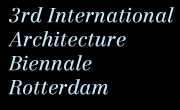PRESS RELEASE International Architecture Biennale Rotterdam
September 3, 2007
Kees Christiaanse appointed curator International Architecture Biennale Rotterdam 2009
The board of the Biennale has appointed Kees Christiaanse as curator of the 4th International Architecture Biennale Rotterdam, in 2009.
Prof. Ir. Kees Christiaanse (1953) studied Architecture at the Delft University of Technology. Between 1980 and 1989, Christiaanse worked for the Office for Metropolitan Architecture in Rotterdam, becoming a partner in 1983. In 1989, he started his own firm in Rotterdam, KCAP. In 1990 he founded ASTOC Architects & Planners in Cologne.
KCAP is an internationally operated Dutch design firm specialized in architecture and urbanism. KCAP's oeuvre is wide in scope and ranges from complex urban transformations and landscape design to architecture and interiors. More than 140 projects have been designed since its founding, of which more than 60 are realized in the Netherlands and Germany. Furthermore, KCAP participates in European and Asian based projects.
From 1996 until 2003 Christiaanse was professor of Architecture and Urban Design at the Berlin University of Technology. He is now professor at the Swiss Federal Institute of Technology in Zurich. He regularly acts as a jury member for international competitions, and is the author of several publications about architecture and urban design.
International Architecture Biennale Rotterdam 2007 success
On September 2, the 3rd International Architecture Biennale Rotterdam closed its doors. The four main exhibitions –Visionary Power, The New Dutch City, A Better World/Another Power and Form and the City– at the Kunsthal Rotterdam, the Dutch Architecture Institute (NAi) and the Maashavengebouw received 77.500 visitors, an increase of more than 30% compared to 2005.
The Berlage Institute curated this 3rd biennale edition that focused on urbanization and had as its theme: ”POWER – Producing the Contemporary City”.
Every single day over 150,000 people migrate to the city. The need for architects and urban planners to project and think ahead is urgent. This sense of urgency was the ultimate message of a biennale that successfully acted as a platform for young contemporary architects with a plan, with the will to grasp control of the idea of the city again, and respond to a call-to-arms for advocacy and real engagement in the urban process.
Biennale-director George Brugmans is optimistic: “The great success of this edition has resulted in an even stronger support for the future of this research oriented biennale that wants to function as an international platform for all related parties: architects, urban planners, academics, politicians, administrators and market parties. So we’re delighted that Kees Christiaanse has accepted to be the next edition’s curator; he is the ideal choice given our decision to continue to focus on the future of the city and the issues raised by unbridled urbanization.”
POWER -
Producing the Contemporary City
24 May - 2 September 2007
Producing the Contemporary City
24 May - 2 September 2007
Kees Christiaanse appointed curator next biennale |
Nederlands | English
"The informal city doesn't produce garbage. It recycles itself." (Alfredo Brillembourg and Hubert Klumpner in Carácas. The Informal City, 2007)

